1) One-line summary
This indicator (by Fluxchart) compares the wick-to-body ratio of the latest candle to historical analogues and projects an average forward path on your chart, color-coding each forecast step by dispersion/confidence.
2) The problem it solves (TL;DR)
Candlestick wicks vs bodies often reveal imbalance between aggressive and passive flows. Instead of reading a single candle in isolation, this tool hunts the past for candles with similar wick/body structure, then projects the typical path that followed comparable setups—giving you a data-driven, visual “what usually happens next” for the next N bars.
3) How it works — intuition
- Compute a ratio per candle that encodes wick/body relationships (four modes available).
- Find historical candles whose ratio is sufficiently close to the current one (optionally only same bullish/bearish direction).
- For each match, take the price trajectory around the match (see “Algorithm details”) and average those trajectories to draw a forecast line ahead of the current bar.
- Use dispersion (standard deviation) among matched paths to color each segment: tighter agreement ⇒ lower dispersion; wider disagreement ⇒ higher dispersion.
Practical read: the slope of the projected line suggests likely path; the color hints at confidence.
4) The four ratio modes (when to use which)
- General Ratio (default)
Compares total wick length to body, signed by candle direction.
Use it for a balanced, all-purpose analogue search. - Top Wick Ratio
Focuses on the upper wick relative to body, signed by direction.
Use it when upper rejections/exhaustion (selling into highs) are central to your thesis. - Bottom Wick Ratio
Focuses on the lower wick relative to body, signed by direction.
Use it for hammer-type absorption or lower-shadow demand clues. - Body Ratio
Body vs full range.
Use it to emphasize closing strength within the bar’s range (breakout/drive conditions).
5) Inputs & defaults (cheat sheet)
| Input | Default | What it does | Typical tweaks |
|---|---|---|---|
loopback |
400 | How many past bars to scan for analogues. | 200–1000 depending on timeframe/market history. |
forecast |
10 | Number of forecast bars to draw ahead. | 5 (scalping) to 20 (swing). |
ratioType |
1 | 1=General, 2=Top Wick, 3=Bottom Wick, 4=Body. | Switch per setup hypothesis. |
directionBias |
1 | If 1, only compare candles with the same direction (bull/bear). | Set 0 to allow cross-direction analogues. |
defaultAccuracy |
2 | Initial tolerance for ratio matching: 1=High (strict), 2=Medium, 3=Low (loose). | Tighten for clean regimes; loosen in noisy ones. |
deviationHigh(R,G,B) |
255,0,0 | Color when dispersion is high (lower confidence). | Adjust to your palette. |
deviationLow(R,G,B) |
0,0,255 | Color when dispersion is low (higher confidence). | Adjust to your palette. |
trendSquare |
1 | Draw a box around each matched analogue window. | Turn off for a cleaner chart. |
trendSquareLabels |
1 | Show ratio labels for current & matched candles. | Useful for debugging/tuning. |
displayLogs |
1 | Show on-chart warnings (e.g., no matches). | Keep on while calibrating. |
Note on colors: by default blue = lower dispersion (higher agreement), red = higher dispersion (lower agreement).
6) What you’ll see on the chart
- Forecast polyline ahead of the last bar: one segment per future step up to
forecast. - Color per segment from dispersion: blue ≈ more agreement among matches; red ≈ less.
- Boxes around historical analogue windows (if enabled), so you can visually audit what the indicator considered “similar.”
- Text labels with the computed ratio for the current bar and each match (if enabled).
7) Algorithm walkthrough (step by step)
- Compute the ratio & sign
- Based on
ratioType, the indicator calculatesmyRatiousing OHLC and assigns a sign from candle direction (bullish = +, bearish = −). - The General mode normalizes total wick vs body; Top/Bottom isolate upper/lower wick contributions; Body uses body vs full range.
- Based on
- Adaptive matching loop
- Start from an initial
accuracy(0.02, modified bydefaultAccuracy). - Scan up to
loopbackbars back. For each past bari, compare absolute ratios|myRatio[i]|vs|myRatio[1]|. - A match occurs if the difference ≤ accuracy and, when
directionBias=1, the sign matches. - The loop widens accuracy if < 5 matches, tightens if > 15; otherwise it accepts the set (guarded by a safety loop of 20 passes).
- If accuracy exceeds 0.10 with zero matches, a warning is displayed and the routine exits.
- Start from an initial
- Build the forecast path from analogues
- For each matched bar, the code aggregates relative price changes over the
forecastlength into arrays:
candleValue = close[i - y - 1] - close[i]for y = 0…forecast-1. - Those values are averaged across matches to obtain an average trajectory
avgCurrent,avgNext.
Implementation nuance: the indicator projects forward the average pre-move path around each analogue, applied from today’s close. In practice, this works like a pattern-shape template.
- For each matched bar, the code aggregates relative price changes over the
- Confidence via dispersion
- It computes a standard deviation for each step from the sums of squares, and toggles the color:
low dispersion ⇒deviationLow(default blue), high dispersion ⇒deviationHigh(default red).
- It computes a standard deviation for each step from the sums of squares, and toggles the color:
- Draw it
- The forecast is drawn ahead of the last bar using
DRAWSEGMENT, fromclose[1] + avgCurrenttoclose[1] + avgNext, step by step.
- The forecast is drawn ahead of the last bar using
7) ProBuilder code
|
1 2 3 4 5 6 7 8 9 10 11 12 13 14 15 16 17 18 19 20 21 22 23 24 25 26 27 28 29 30 31 32 33 34 35 36 37 38 39 40 41 42 43 44 45 46 47 48 49 50 51 52 53 54 55 56 57 58 59 60 61 62 63 64 65 66 67 68 69 70 71 72 73 74 75 76 77 78 79 80 81 82 83 84 85 86 87 88 89 90 91 92 93 94 95 96 97 98 99 100 101 102 103 104 105 106 107 108 109 110 111 112 113 114 115 116 117 118 119 120 121 122 123 124 125 126 127 128 129 130 131 132 133 134 135 136 137 138 139 140 141 142 143 144 145 146 147 148 149 150 151 152 153 154 155 156 157 158 159 160 161 162 163 164 165 166 167 168 169 170 171 172 173 174 175 176 177 178 179 180 181 182 183 184 185 186 187 188 189 190 191 192 193 194 195 196 197 198 199 200 201 202 203 204 205 206 207 208 209 210 211 212 213 214 215 216 217 218 219 220 221 222 223 224 225 226 |
//-------------------------------------------// //PRC_Wick to Body Ratio Trend Forecast by fluxchart //version = 0 //14.10.2025 //Iván González @ www.prorealcode.com //Sharing ProRealTime knowledge //-------------------------------------------// // --- ALGORITHM SETTINGS --- // Number of candles to look back loopback = 400 // Bar length of the forecast lines forecast = 10 // Ratio Type to use: 1=General, 2=Top Wick, 3=Bottom Wick, 4=Body ratioType = 1 // If 1, only candles of the same direction (bullish/bearish) are compared directionBias = 1 // 1=true, 0=false // Initial Accuracy: 1=High, 2=Medium, 3=Low defaultAccuracy = 2 // --- FORECAST LINES --- // High confidence color (R,G,B values) deviationHighR = 255 deviationHighG = 0 deviationHighB = 0 // Low confidence color (R,G,B values) deviationLowR = 0 deviationLowG = 0 deviationLowB = 255 // --- PAST TRENDS --- // 1 = Draws a box around matching past trends trendSquare = 1 // 1 = Labels the ratios of matching candles trendSquareLabels = 1 // --- OTHER --- // 1 = Displays warning messages on the chart displayLogs = 1 // --- VARIABLE INITIALIZATION --- ONCE accuracy = 0.02 IF defaultAccuracy = 1 THEN accuracy = 0.01 ELSIF defaultAccuracy = 3 THEN accuracy = 0.04 ENDIF ONCE ratioNotFindable = 0 ONCE lastBar = 0 ONCE matchesFound = 0 ONCE loopBreaker = 0 // --- CANDLE RATIO CALCULATION --- myRatio = 0 sign = 0 IF (close - open) > 0 THEN sign = 1 ELSIF (close - open) < 0 THEN sign = -1 ENDIF // General Ratio IF ratioType = 1 THEN IF ABS(close - open) > 0 THEN myRatio = ((ABS(low - high) - ABS(close - open)) / ABS(close - open)) * sign ELSE myRatio = 0 ENDIF // Top Wick ELSIF ratioType = 2 THEN IF ABS(close - open) > 0 THEN myRatio = ((MAX(close, open) - high) / ABS(close - open)) * sign ELSE myRatio = 0 ENDIF // Bottom Wick ELSIF ratioType = 3 THEN IF ABS(close - open) > 0 THEN myRatio = ((MIN(close, open) - low) / ABS(close - open)) * sign ELSE myRatio = 0 ENDIF // Body Ratio ELSIF ratioType = 4 THEN IF ABS(high - low) > 0 THEN myRatio = (ABS(close - open) / ABS(high - low)) * sign ELSE myRatio = 0 ENDIF ENDIF // --- MAIN LOGIC (RUNS ON THE LAST BAR) --- IF ISLASTBARUPDATE THEN // Clear arrays for new calculation UNSET($sumArray) UNSET($sumOfSquaresArray) // Label for the current candle's ratio IF trendSquareLabels = 1 THEN ratio = ROUND(myRatio[1]*100)/100 DRAWTEXT("Ratio: #ratio#", barindex[1], high[1] + (high[1]-low[1])*0.5) COLOURED(0,0,255) ENDIF // Loop to adjust accuracy and find matches matchesFound = 0 loopBreaker = 0 WHILE loopBreaker < 20 DO // Safety loop to prevent infinite loops matchesFound = 0 lastBar = 0 // Reset accumulation arrays FOR f = 0 TO forecast - 1 DO $sumArray[f] = 0 $sumOfSquaresArray[f] = 0 NEXT // Main loop to search through historical data FOR i = forecast + lastBar TO (loopback + forecast) DO barsDifference = ABS(ABS(myRatio[i]) - ABS(myRatio[1])) ratioSignI = 0 IF myRatio[i] > 0 THEN ratioSignI = 1 ELSIF myRatio[i] < 0 THEN ratioSignI = -1 ENDIF ratioSignCurrent = 0 IF myRatio[1] > 0 THEN ratioSignCurrent = 1 ELSIF myRatio[1] < 0 THEN ratioSignCurrent = -1 ENDIF ratioDirectionMatch = (ratioSignI = ratioSignCurrent) IF (barsDifference <= accuracy AND ratioDirectionMatch) OR (barsDifference <= accuracy AND directionBias = 0) THEN matchesFound = matchesFound + 1 // Accumulate values for the forecast FOR y = 0 TO forecast - 1 DO candleValue = close[i - y - 1] - close[i] $sumArray[y] = $sumArray[y] + candleValue $sumOfSquaresArray[y] = $sumOfSquaresArray[y] + POW(candleValue, 2) NEXT // Draw boxes and labels on past matches IF trendSquare = 1 OR trendSquareLabels = 1 THEN mytop = highest[forecast](high[i-1]) mybottom = lowest[forecast](low[i-1]) IF trendSquare = 1 THEN DRAWRECTANGLE(barindex[i], mytop, barindex[i - forecast], mybottom) COLOURED(192,192,192)fillcolor(192,192,192,50) ENDIF IF trendSquareLabels = 1 THEN directionColorR = 255 directionColorG = 0 IF myRatio[i] > 0 THEN directionColorR = 0 directionColorG = 255 ENDIF ratio = ROUND(myRatio[i]*100)/100 DRAWTEXT("Match: #ratio#", barindex[i], high[i] + (high[i]-low[i])*0.5) COLOURED(directionColorR, directionColorG, 0) ENDIF ENDIF // Update to avoid repeating the same candle (optimization) lastBar = i ENDIF NEXT // Accuracy adjustment logic IF matchesFound < 5 THEN accuracy = accuracy + 0.01 ELSIF matchesFound > 15 THEN accuracy = accuracy - 0.005 ELSE ratioNotFindable = 0 BREAK // Exit the WHILE loop ENDIF IF accuracy > 0.1 AND matchesFound = 0 THEN ratioNotFindable = 1 IF displayLogs = 1 THEN DRAWTEXT("WARNING: No matches found.", barindex - 50, high) ANCHOR(TOPLEFT, INDEX, YSHIFT) COLOURED(255,165,0) ENDIF BREAK ENDIF loopBreaker = loopBreaker + 1 WEND // --- DRAWING THE FORECAST LINE --- IF ratioNotFindable = 0 AND matchesFound > 0 THEN deviation = (ArrayMax($sumArray)/matchesFound - ArrayMin($sumArray)/matchesFound) / 2 FOR i = 0 TO forecast - 2 DO avgCurrent = $sumArray[i] / matchesFound avgNext = $sumArray[i+1] / matchesFound // Calculate standard deviation for color sumSqCurrent = $sumOfSquaresArray[i] stdevCurrent = SQRT((sumSqCurrent / matchesFound) - POW(avgCurrent, 2)) // Simulate gradient color lineR = deviationLowR lineG = deviationLowG lineB = deviationLowB IF stdevCurrent > deviation / 2 THEN lineR = deviationHighR lineG = deviationHighG lineB = deviationHighB ENDIF // Draw a segment of the forecast line DRAWSEGMENT(barindex + i + 1, close[1] + avgCurrent, barindex + i + 2, close[1] + avgNext) STYLE(Line, 2) COLOURED(lineR, lineG, lineB) NEXT ENDIF ENDIF RETURN |
Share this
No information on this site is investment advice or a solicitation to buy or sell any financial instrument. Past performance is not indicative of future results. Trading may expose you to risk of loss greater than your deposits and is only suitable for experienced investors who have sufficient financial means to bear such risk.
ProRealTime ITF files and other attachments :PRC is also on YouTube, subscribe to our channel for exclusive content and tutorials
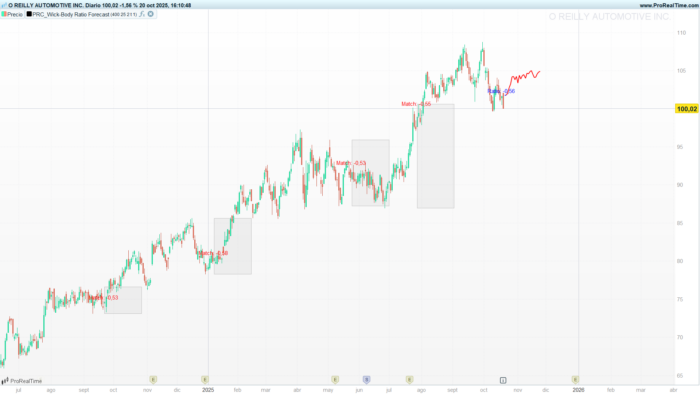

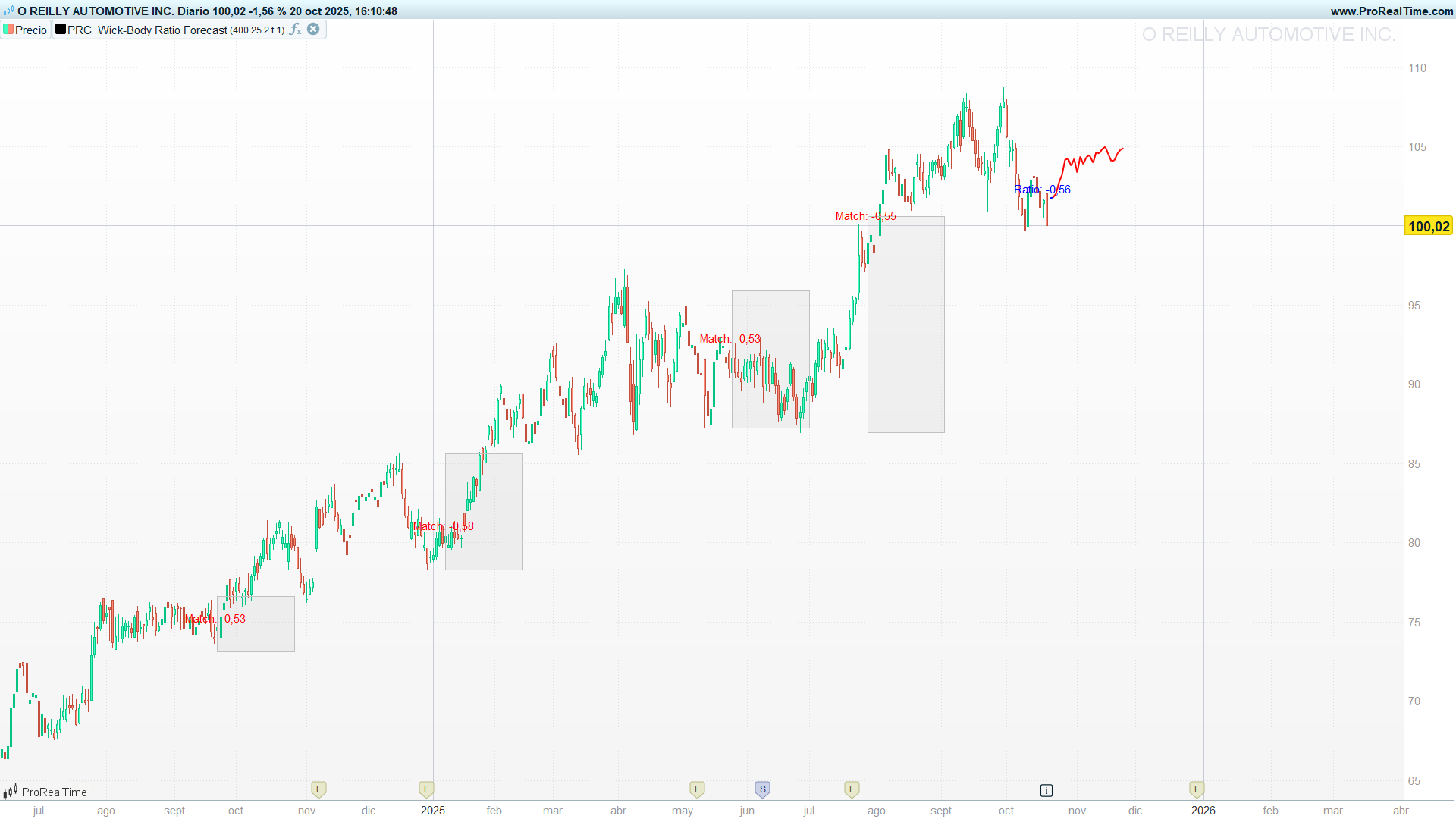

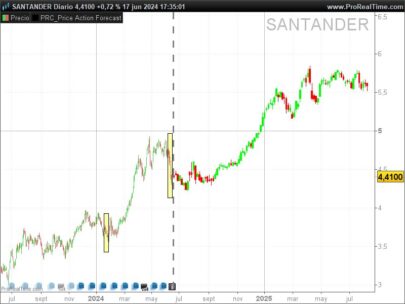
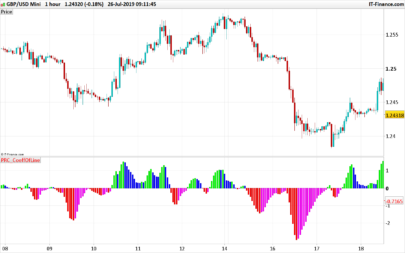
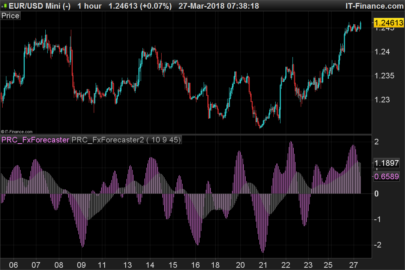
Hi Ivan,
error when importing, please check with thanks.
you can always copy/paste
but it loop back and make many boxes
Eccezionale. E’ stato testato per vedere la % di OK?
copy the code and create the indicator manually and it works.